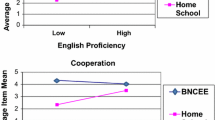Abstract
In this paper, we describe changes in students' ideas about science classes, attitudes about science, and motivations for studying science, in a classroom designed to support projectbased science learing. Using a survey designed to provide a measure of students' attitudes towards science classes and science, we have compared students enrolled in a traditional high school biology course, with students enrolled in an integrated, project-based science course called Foundations I. Survey responses were analyzed to look at differences between and within two groups of students over the course of one school year. In general, the results of this study suggest that providing students with opportunities to collect and analyze their own data in science classes results in a change in students' ideas about science classrooms. Foundations I students' increased tendency to agree with statements about ‘using information,’ ‘drawing conclusions,’ and ‘thinking about problems,’ implies a change in their understanding of what it means to do science in school. These students, in contrast to students in the traditional Biology course, no longer describe their science experience as one of memorization, textbook reading, and test taking. Instead they see science class as a place in which they can collect data, draw conclusions, and formulate and solve problems.
Similar content being viewed by others
References
Blumenfeld, P., Krajcik, J., Marx, R., and Soloway, E. (1994). Lessons Learned: How Collaboration Helped Middle School Teachers Learn Project Based Instruction.The Elementary School Journal 94(5): 539–551.
Heubel-Drake, M., Mouradian, M., and Stern, E. (1994). Foundations I Syllabus, Fall 1994. Unpublished class handout.
Hounshell, P., and Hill, S. (1989). The Microcomputer and Achievement and Attitudes in High School Biology.Journal of Research in Science Teaching, 26(6): 543–549.
Krajcik, J., Blumenfeld, P., Marx, R., and Soloway, E. (1994). A Collaborative Model for Helping Science Teachers Learn Projectbased Instruction.The Elementary School Journal, 94(5): 483–498.
Marx, R., Blumenfeld, P., Krajcik, J., Blunk, M., Crawford, B., Kelly, B., and Meyer, K. (1994). Enacting Project-based Science: Experiences of Four Middle Grade Teachers.The Elementary School Journal, 94(5): 517–538.
Roupp, R. R., Gal, S., Drayton, B., and Pfister, M. (Eds.), (1992).LabNet: Toward a Community of Practice. Erlbaum, Hillsdale, New Jersey.
Towle, A. (1989).Modern Biology, Holt, Rinehart and Winston, New York.
Author information
Authors and Affiliations
Corresponding author
Rights and permissions
About this article
Cite this article
Stratford, S.J., Finkel, E.A. The impact of scienceware and foundations on students' attitudes towards science and science classes. J Sci Educ Technol 5, 59–67 (1996). https://doi.org/10.1007/BF01575471
Issue Date:
DOI: https://doi.org/10.1007/BF01575471




